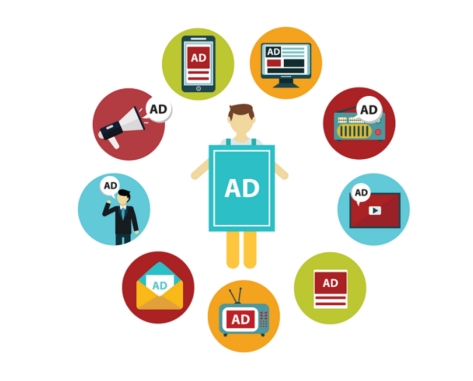LESSON OVERVIEW
We want to kick off this year with an online advertising lesson plan. It’s a multipurpose lesson as you can use it with professionals interested in advertising and marketing but it is not very much business-oriented so it was also a success with students outside the ad industry. In this lesson, your students will:
- discover different ad types and formats
- do jigsaw reading to learn about the history of advertising on the Internet
- discuss how the advertising industry affects the Internet
- see how emojis (and our online activity) are used in new ads
WARM-UP
Our online advertising lesson plan starts with a short lead-in task where students have a chance to talk about their experience and opinions on annoying ads. Next, they need to show their knowledge of the online ad world by identifying various types of ads. You will distribute six images of Internet ads (pages 5-6 in the Teacher’s version) and ask your students to match them with their names.
JIGSAW READING AND VOCABULARY
We don’t post many lesson plans with reading tasks here. Of course, developing reading skills is important in learning a language but we think there are other places where you can get such resources. Nevertheless, when we include reading in our lessons we want to make it as interactive as possible. This is why we decided to go for a jigsaw reading task! In our online advertising lesson plan, students will have to read half of a (shortened) article on the history of online ads. The way you want to approach it is to split the text into 2 parts (sections 1-3 and 4-6) and ask students to read just their part and then share what they’ve learnt with each other. Try not to explain any of the underlined words as these will be used in the next exercise.
In the next task, Students match new words with their synonyms. Give each student one column corresponding to the sections they’ve read. If you want to spend more time on that, ask Students to swap their sections so they have to look into a new piece of text. If not, then give the other part of the text and a corresponding vocabulary as homework.
POST-READING DISCUSSION
This is where students can talk about online advertising much more. Some of the questions there are broad and may spark a longer debate. Decide how much time you want to spend on this. We recommend 10-15 mins max.
VIDEO AND DISCUSSION
The YouTube video we chose for this lesson focuses on the use of emojis in advertising. Therefore, first we go into explaining or negotiating the meaning of some of the popular emojis. Our suggested answered are based on emojipedia and our own knowledge but some emojis may have different meaning depending on culture.
After learning about some emojis, watch the video with your students. There is no listening comprehension task this time but instead you will have your students talking about its content and the consequences of targeting ads in the way described there.
EXTRA TASK – EMOJI PUZZLES
Finish your lesson with some fun task. We have created emoji puzzles that your students need to decipher to guess what idiomatic expressions they hide. There are 2 sets with 8 puzzles each and obviously the answers if your students give up/ See the last page of Teacher’s Worksheet for the puzzles and answer sheets.
DESCRIBING ADVERTISING
We brought an extra worksheet to build on the topic of our online advertising lesson plan. The extra worksheet consists of three activities and three sets of creative ads to practise describing images and presented concept.
WORKSHEETS
Subscribe to unlock these and many other Standalone lesson with the Premium plan
Subscribe














Amazing class. Thanks a lot!
Great to hear it 🙂
It’s linked in the lesson overview in the Describing Advertising paragraph. Here’s the link as well: https://eslbrains.com/clever-advertising-describing-ads/
Great, thank you
So good! This one works really well with tech workers! Interesting and fun! I’m a big fan of the end of class activities, like in this one, or with roleplays! Students always like them! They’re such an interactive and beneficial way for the students to finish off the class.
You mean the emoji puzzle one? I remember that creating it was fun! We’re also big proponents of using creative tasks in the classroom such as role plays, case studies or group work in which students need to think critically.
The student activity sheet doesn’t have the underlined words to match to the synonyms!
I suppose you’re referring to ex. 3 and 4. The weird thing is that all is okay on the worksheets (at least from what I see). E-mail me a screenshot of the version you see to [email protected] so that we can check what’s going on.
It’s good but when you click on the links to the article its all a bit messed up. Part 1 = 2,3,4. Part 2 = 5,6
Thanks for the comment! This jigsaw reading task in the e-lesson plan is divided into 3 sections:
1. paragraph 1 is read by both groups
2. paragraphs 2-4 are read by Student A
3. paragraphs 5-6 are read by Student B
The PDF version differs a bit. There the task is divided into 2 parts: Student A – 1-3, Student B – 4-6. The difference comes from the fact that we wanted to adapt the task for online lessons, and the constraints of working in digital presentation format.
Sorry for the confusion! I guess we could change the pdfs to have the same task everywhere and avoid such issues.
The links to the reading parts can’t be found
The reading parts are linked in the buttons on slide 13 and if you use the PDFs, then the texts are included there 🙂